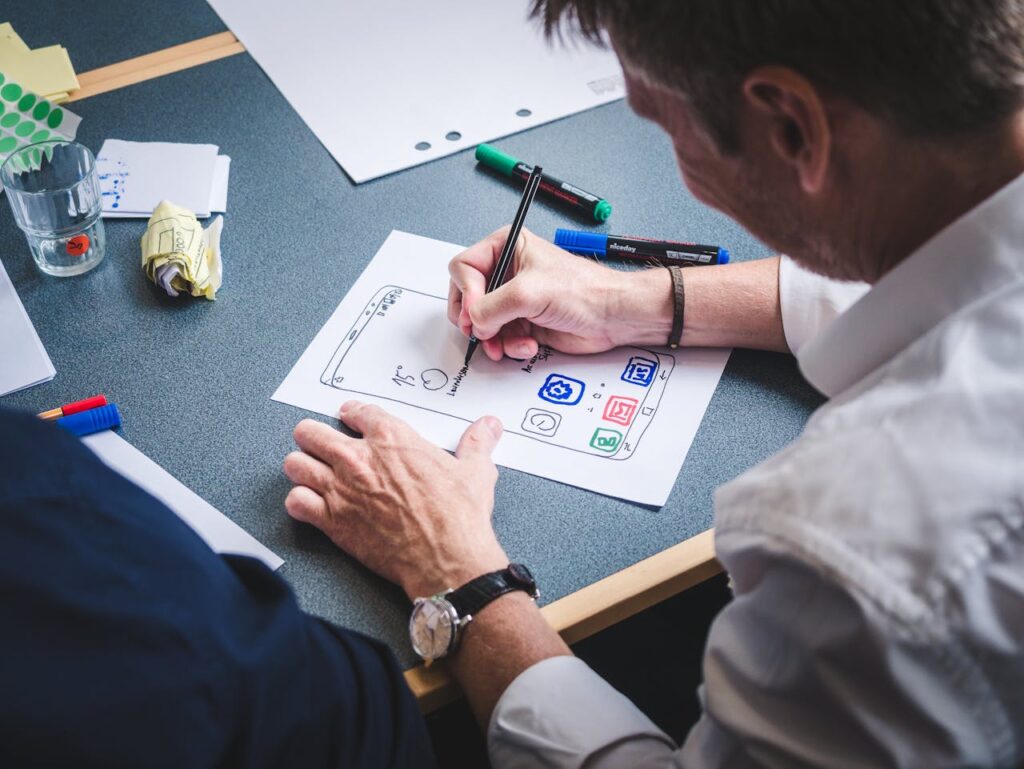Learn about various facilitation and training methods focused on fostering interaction and engagement through experiences
Facilitation and training methods that focus on experiential learning and participant engagement are essential for fostering innovation, creativity, and collaboration within organizations. Design Thinking is a foundational approach we use that influences how these programs are designed and facilitated, emphasizing empathy, ideation, and iterative problem-solving. Below is a guide to various methods that align with this participant-focused style.
Design Thinking as a Foundation
Design Thinking is a human-centered approach to innovation that draws from the designer’s toolkit to integrate the needs of people, the possibilities of technology, and the requirements for business success. It involves stages: Empathize, Define, Ideate, Prototype, and Test. This approach encourages creative problem-solving and ensures solutions are grounded in real user needs. You can apply this to a business or a learning experience.
Design thinking is helpful at the design stage of the program. The other methods below represent activities or toolkits of activities you can use within the program with your audience.
LEGO® SERIOUS PLAY®
LEGO® SERIOUS PLAY® is a facilitated meeting, communication, and problem-solving method in which participants use LEGO bricks to build models that represent their ideas, reflections, and insights. This hands-on approach deepens the reflection process and supports an effective dialogue for everyone in the organization.
Learn more about creating a LEGO® SERIOUS PLAY® workshop in our companion guide.
Liberating Structures
Liberating Structures are easy-to-learn interaction methods that enhance relational coordination and trust. They are designed to include and unleash everyone in shaping the future. Some popular Liberating Structures include 1-2-4-All, Troika Consulting, and Appreciative Interviews. These structures can be used to facilitate group processes and enable participants to generate innovative ideas.
Open Space Technology
Open Space Technology is a method for organizing meetings of large groups around a central theme. It is particularly effective for complex issues where diverse perspectives are needed. The participants create the agenda themselves and take responsibility for facilitating the sessions. This method fosters creativity, collaboration, and ownership of the outcomes.
Learn more about applying Open Space Technology (OST) in a digital and AI-driven age in this guide.
World Café
World Café is a conversational process that helps groups engage in constructive dialogue, share knowledge, and create possibilities for action. Participants sit at small café-style tables and discuss questions related to a central theme. They move between tables periodically and cross-pollinate ideas, leading to deeper insights and innovative solutions.
Gamestorming
Gamestorming involves using games to encourage innovative thinking and collaboration. These structured play activities are designed to break down barriers, stimulate creative thinking, and generate new ideas. Examples include “Affinity Mapping,” “Cover Story,” and “Empathy Map.” Gamestorming helps teams approach problems from new angles and find unexpected solutions. The Gamestorming book is a great resource to start with.
Utilizing Whiteboard Platforms (like Miro and Mural) for Workshop Activities
Incorporating a variety of activities is crucial for facilitating engaging and productive workshops. Miro and Mural, two leading online collaboration tools, offer extensive libraries of templates that can serve as invaluable resources for planning and executing workshop activities.
Miro
Miro provides a vast array of templates designed to enhance various aspects of workshop facilitation. These templates are crafted to support activities such as brainstorming, strategic planning, and design sprints. Here are some notable types of templates available on Miro:
- Brainstorming: Templates for mind mapping, affinity diagrams, and idea clustering help participants generate and organize ideas efficiently.
- Planning: Use templates for project planning, Gantt charts, and roadmaps to guide teams through structured planning sessions.
- Design Thinking: Empathy maps, journey maps, and prototype templates are tailored to support each stage of the design thinking process.
- Retrospectives: Templates for retrospectives and feedback sessions ensure that teams can reflect on their work and identify areas for improvement.
Miro’s templates are designed to be customizable, allowing facilitators to adapt them to the specific needs of their workshops. This flexibility makes Miro a versatile tool for a wide range of workshop activities.
Mural
Mural is another excellent platform that offers a comprehensive selection of templates to support collaborative workshop activities. The templates in Mural are particularly well-suited for activities that require visual thinking and group interaction. Key types of templates available on Mural include:
- Design Thinking: Templates for empathy maps, stakeholder maps, and user journey maps help teams delve into user-centered design activities.
- Strategic Planning: SWOT analysis, business model canvas, and strategic frameworks are available to guide strategic discussions and planning.
- Team Building: Icebreaker templates and team alignment maps foster team cohesion and set a collaborative tone for workshops.
- Innovation: Idea generation and prioritization templates, such as the SCAMPER technique and impact-effort matrix, facilitate innovative thinking and decision-making.
Mural’s templates are designed to streamline the facilitation process, enabling facilitators to quickly set up and run effective activities. The platform’s focus on visual collaboration ensures that all participants can engage fully, regardless of their location.
By leveraging the rich libraries of templates offered by Miro and Mural, facilitators can enhance their workshops with structured, engaging, and impactful activities. These resources not only simplify the planning process but also ensure that workshops are interactive and productive, driving better outcomes for all participants.
For more detailed explorations on using these templates in your workshops, explore our Miro and Mural introductory guides.
Experiential, Participant-Focused Facilitation and Training Methods Conclusion
These facilitation and training methods are designed to enhance creativity, collaboration, and innovation within organizations. By using these experiential, participant-focused approaches, facilitators can create engaging and productive workshops that drive meaningful outcomes and foster a culture of continuous improvement and innovation. Contact us if you are seeking training or a workshop. For more detailed guides and additional resources, explore the articles and resources available on our blog.
